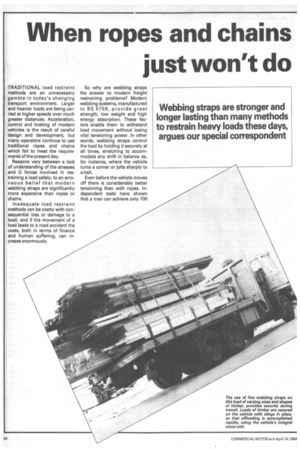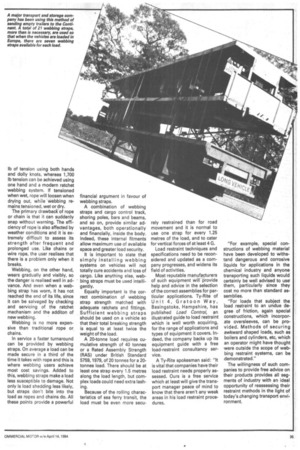When ropes and chains just won't do
Page 36

Page 37

If you've noticed an error in this article please click here to report it so we can fix it.
Webbing straps are stronger and longer lasting than many methods to restrain heavy loads these days, argues our special correspondent
TRADITIONAL load restraint methods are an unnecessary gamble in today's changing transport environment. Larger and heavier loads are being carried at higher speeds over much greater distances. Acceleration, control and braking of modern vehicles is the result of careful design and development, but many operators continue to use traditional ropes and chains which fail to meet the requirements of the present day.
Reasons vary between a lack of understanding of the stresses and G forces involved in restraining a load safely, to an erroneous belief that modern webbing straps are significantly more expensive than ropes or chains.
Inadequate load restraint methods can be costly with consequential loss or damage to a load; and if the movement of a load leads to a road accident the costs, both in terms of finance and human suffering, can increase enormously. So why are webbing straps the answer to modern freight restraining problems? Modern webbing systems, manufactured to BS 5759, provide great strength, low weight and high energy absorption. These factors enable them to withstand load movement without losing vital tensioning power. In other words, webbing straps control the load by holding it securely at all times, stretching to accommodate any shift in balance as, for instance, where the vehicle turns a corner or jolts sharply to a halt.
Even before the vehicle moves off there is considerably better tensioning than with ropes. Independent tests have shown that a man can achieve only 700 lb of tension using both hands and dolly knots, whereas 1,700 lb tension can be achieved using one hand and a modern ratchet webbing system. If tensioned when wet, rope will loosen when drying out, while Webbing remains tensioned, wet or dry.
The primary draWback"of rope or chain is that it can suddenly snap without warning. The efficiency of rope is also affected by weather conditions and it is extremely difficult to assess its strength after frequent and prolonged use. Like chains or wire rope, the user realises that there is a problem only when it breaks.
Webbing, on the other hand, wears gradually and visibly, so the danger is realised well in advance. And even when a webbing strap has worn, it has not reached the end of its life, since it can be salvaged by checking and servicing of the ratchet mechanism and the additon of new webbing.
Webbing is no more expensive than traditional rope or chains.
In service a faster turnaround can be provided by webbing straps. On average a load can be made secure in a third of the time it takes with rope and this is where webbing users achieve most cost savings. Added to this, webbing straps make a load less susceptible to damage. Not only is load shedding less likely, but straps don't bite into the load as ropes and chains do. All these points provide a powerful financial argument in favour of webbing straps.
A combination of webbing straps and cargo control track, shoring poles, bars and beams, and so on, provide similar advantages, both operationally and financially, inside the body. Indeed, these internal fitments allow maximum use of available space and greater load security.
It is important to state that simply installing webbing systems on vehicles will not totally cure accidents and loss of cargo. Like anything else, webbing straps must be used intelligently.
Equally important is the correct combination of webbing strap strength matched with adequate ratchets and fittings. Sufficient webbing straps should be used on a vehicle so that their total breaking strength is equal to at least twice the weight of the load.
A 20-tonne load requires cumulative strength of 40 tonnes or a Rated Assembly Strength (RAS) under British Standard 5759, 1979, of 20 tonnes for a 20tonnes load. There should be at least one strap every 1.5 metres along the load length, but complex loads could need extra lashing.
Because of the rolling characteristics of sea ferry transit, the load must be even more secu
rely restrained than for road movement and it is normal to use one strap for every 1.25 metres of the load, and to cater for vertical forces of at least 4 G.
Load restraint techniques and specifications need to be reconsidered and updated as a company progresses, and widens its field of activities.
Most reputable manufacturers of such equipment will provide help and advice in the selection of the correct assemblies for particular applications. Ty-Rite of Unit 4, Gratoon Way, Basingstoke, Hampshire, has published Load Control, an illustrated guide to load restraint which is well worth acquiring, for the range of applications and types of equipment it covers. Indeed, the company backs up its equipment guide with a free load-restraint consultancy service.
A Ty-Rite spokesman said: "It is vital that companies have their load restraint needs properly assessed. Ours is a free service which at least will give the transport manager peace of mind to know that there aren't any weak areas in his load restraint procedures. "For, example, special constructions of webbing material have been developed to withstand dangerous and corrosive liquids for applications in the chemical industry and anyone transporting such liquids would certainly be well advised to use them, particularly since they cost no more than standard assemblies.
"For loads that subject the load restraint to an undue degree of friction, again special constructions, which incorporate oversleeves, can be provided. Methods of securing awkward shaped loads, such as boilers and cylinders, etc, which an operator might have thought .were outside the scope of webbing restraint systems, can be .demonstrated."
The willingness of such companies to provide free advice on their products provides all segments of industry with an ideal opportunity of reassessing their restraint methods in the light of today's .changing transport environment.




























































































